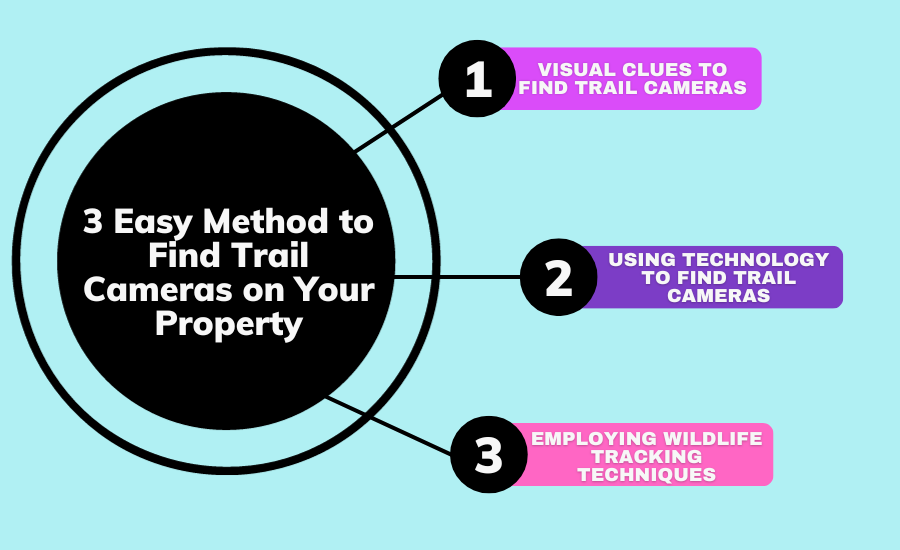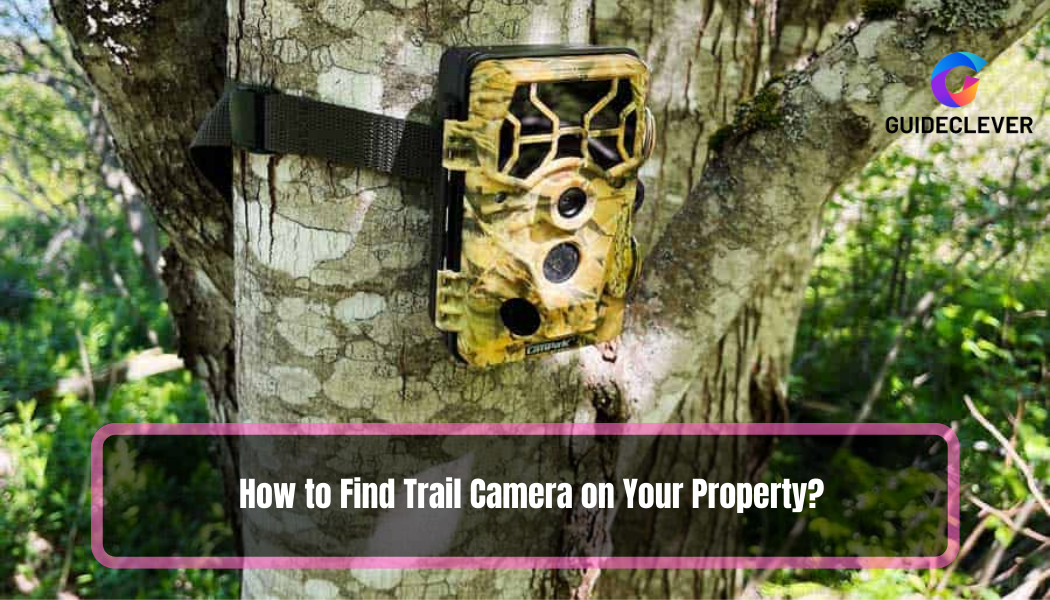In recent years, trail cameras have become more common. They serve different purposes, like monitoring wildlife and increasing security. They also capture amazing glimpses of nature. These devices give us useful information.
But it can be worrying when they show up on our property without asking. We all want privacy and security in our homes, which creates a sense of sanctuary. In this comprehensive guide, we will discover how to find trail cameras on your property. We’ll learn different methods, like observing and using technology, to track wildlife.
This guide helps homeowners, nature enthusiasts, and those interested in privacy. Use it to learn about trail cameras and how to handle them legally and responsibly. Now, let’s start looking for hidden cameras in the wild to protect our privacy.
Contents
- 1 Understanding Trail Cameras
- 2 Why You Should Locate Trail Cameras
- 3 Find Trail Cameras on Your Property with 3 Easy Methods
- 4 Method 01: Visual Clues to Find Trail Cameras
- 5 Method 02: Using Technology to Find Trail Cameras
- 6 Method 03: Employing Wildlife Tracking Techniques
- 7 What to Do If You Find a Neighbor Trail Camera on Your Property
- 8 01. Communicating with Neighbors
- 9 02. Privacy and Legal Considerations
- 10 Conclusion
- 11 FAQ’s on How to Find Trail Cameras on Your Property
- 11.1 Q1. Why should I be concerned about trail cameras on my property?
- 11.2 Q2. What are some visual clues to look for when trying to find trail cameras?
- 11.3 Q3. Are there any smartphone apps that can help me find trail cameras?
- 11.4 Q4. What legal considerations should I be aware of when trying to locate trail cameras on my property?
- 11.5 Q5. How can I approach my neighbor if I suspect they have placed trail cameras on my property?
Understanding Trail Cameras
Before we delve into the techniques for finding trail cameras. It’s essential to understand what trail cameras are and how they work. Trail cameras, also known as game cameras or wildlife cameras. They are specialized devices designed for remote monitoring. They are commonly used for wildlife observation, property security, and research purposes. Here’s a brief overview of what trail cameras are and how they work:
What They Are:
- Trail cameras are small cameras that can withstand different weather conditions. They have sensors that detect motion and sometimes infrared detectors.
- These are often used outdoors and can be attached to trees, posts, or other structures.
How They Work:
- Trail cameras use motion sensors and heat detectors to find movement or changes in heat.
- When the camera detects motion or heat, it starts capturing images or recording video.
- Trail cameras can take pictures or record videos, depending on how they are set up.
- Trail cameras can capture nighttime footage using infrared technology instead of visible light.
- Images and videos are saved on removable memory cards, like SD cards.
- Battery-powered devices are designed to run for a long time without supervision. They use batteries as their power source.
Why You Should Locate Trail Cameras
Trail cameras are used for many reasons. They help monitor wildlife, secure property, and aid in hunting. It is important to know if there are trail cameras on your property.
- Privacy Concerns: Trail cameras can capture images and videos without your knowledge. or consent potentially infringing on your privacy.
- Security: If you suspect unauthorized trail cameras on your property. it’s crucial to find and remove them to maintain your security.
- Wildlife Monitoring: Locating trail cameras can help you understand what’s being monitored on your property. which can be useful for wildlife enthusiasts.
Find Trail Cameras on Your Property with 3 Easy Methods

Trail cameras are useful for watching wildlife and improving security. It’s important to know if they’re on your property for privacy and safety. Luckily, you have three simple ways to find trail cameras without being noticed.
Method 01: Visual Clues to Find Trail Cameras
To use this method, you need to be observant and notice any signs left by trail cameras.
- Wires: Some trail cameras require power sources or data storage devices. That may be connected by visible wires. Inspect nearby trees, branches, or structures for these wires.
- Lenses: Trail camera lenses are often small and round or rectangular in shape. These lenses may catch and reflect light, making them visible even from a distance.
- Housing: Trail cameras are typically housed in weather-resistant. In cases to protect them from the elements. These cases may appear different from nature due to their design and color.
- Positioning: Check common mounting locations. like trees, fence posts, or bushes where trail cameras are often placed. Pay attention to unusual objects that may not belong in the natural environment.
Method 02: Using Technology to Find Trail Cameras
Modern technology offers several tools to assist in locating trail cameras:
- Smartphone Apps: Some apps claim to detect the presence of trail cameras. using your phone’s camera and flash. These apps can find reflections or infrared light that the naked eye can’t see.
- Infrared Detectors: Infrared detectors are small devices. You can use it to find infrared lights on trail cameras that see at night. These detectors can be pointed at suspected areas to detect infrared emissions.
Method 03: Employing Wildlife Tracking Techniques
Wildlife enthusiasts often use their knowledge of animal behavior to locate trail cameras:
- Animal Behavior: Observe the behavior of animals on your property. Animals might act strangely. like avoiding certain places or showing distress when they spot trail cameras.
- Tracks and Patterns: Look for animal tracks that lead to potential camera locations. When animals come near or avoid a trail camera, they might leave tracks or disturb the area.
You can use these three methods to see if there are trail cameras on your property. When investigating these devices, it's important to respect privacy and follow legal regulations. If you think someone has put up secret cameras or you're worried about your privacy. Talk to your neighbors or get legal help to deal with the problem.
What to Do If You Find a Neighbor Trail Camera on Your Property
01. Communicating with Neighbors
If you suspect your neighbor installed trail cameras, good communication is important. Here’s how to handle this situation responsibly:
1. Approach with Calmness and Respect:
- Initiate the conversation calmly and respectfully. Avoid jumping to conclusions or making accusations.
- Pick a good time and location for the talk, so there are no interruptions and you can talk in private.
2. Express Your Concerns:
- Please express your concerns and reasons for wanting to talk about trail cameras.
- Use “I” statements to express how the cameras make you feel. Emphasizing your own perspective rather than making accusatory statements.
3. Listen Actively:
- Give your neighbor an opportunity to explain their reasons for placing the cameras. They may have legitimate concerns or purposes.
- Be open to listening to their perspective, even if you disagree.
4. Seek Common Ground:
- Think about different solutions to balance your privacy and your neighbor’s needs.
- Finding common ground can lead to a resolution that benefits both parties.
5. Maintain a Respectful Tone:
- Keep the conversation civil and avoid confrontational language or behavior.
- Keep in mind, you want to fix the problem and stay on good terms with your neighbor.
02. Privacy and Legal Considerations
Understanding the legal aspects of finding trail cameras on your property. It is crucial before taking any action. Laws regarding property rights and privacy vary by location. Also, it’s essential to ensure that you are complying with the law. Here are some key points to consider:
1. Property Rights: In many jurisdictions. property owners have certain rights and control over what happens on their property. Unauthorized placement of trail cameras on your property may infringe on these rights.
2. Privacy Laws: Privacy laws vary. But they often protect individuals from unwarranted surveillance on their property. Unauthorized recording of people without their consent may violate privacy laws.
3. Trespassing: Placing trail cameras on someone else’s property without permission. It may constitute trespassing, which can have legal consequences.
4. Local Regulations: Consult local regulations and ordinances. or bylaws that may govern the use of surveillance equipment on private property.
5. Legal Guidance: If you are unsure about the legal implications of trail cameras. If you need help with the law, talk to a lawyer who knows the rules in your area.
To handle the situation responsibly, learn the laws and talk to your neighbor. If needed, use legal action to protect your rights and privacy. Open communication is often the first step in resolving such issues amicably.
Conclusion
We hope you’ve learned valuable information about finding trail cameras on your property. It’s important to discover, protect privacy, and communicate responsibly. Trail cameras are important tools. But they can disrupt the balance between privacy and observation.
Don’t forget, nature is amazing, and trail cameras show its beauty. It is important to protect our safety and privacy in our homes.
You can use this guide to protect your privacy and security. It covers methods like visually spotting clues and understanding wildlife behavior. You’ll also learn how to use technology effectively. To responsibly explore this area, ask your neighbors about the laws for trail cameras.
FAQ’s on How to Find Trail Cameras on Your Property
Q1. Why should I be concerned about trail cameras on my property?
- To keep your privacy and security, it’s important to check for trail cameras on your property. This helps protect your personal space. Unauthorized cameras can potentially infringe on your privacy and may raise security concerns.
Q2. What are some visual clues to look for when trying to find trail cameras?
- You can look for visual clues to find a hidden camera. These clues include visible wires, camera lenses, weather-resistant housing, and common mounting locations.
Q3. Are there any smartphone apps that can help me find trail cameras?
- Yes, you can use smartphone apps to find trail cameras with your phone’s camera and flash. These apps try to find reflections or infrared light that the naked eye can’t see.
Q4. What legal considerations should I be aware of when trying to locate trail cameras on my property?
- Laws regarding property rights, privacy, and surveillance equipment usage vary by location. If you are worried about the legality of trail cameras on your property. It’s important to respect the laws and seek advice from legal authorities or experts.
Q5. How can I approach my neighbor if I suspect they have placed trail cameras on my property?
- Approach your neighbor calmly and respectfully to discuss the situation. Express your concerns and listen to their perspective as well. Discover common interests and create solutions that honor privacy and respect their interests. Open communication is key to resolving such issues amicably.


